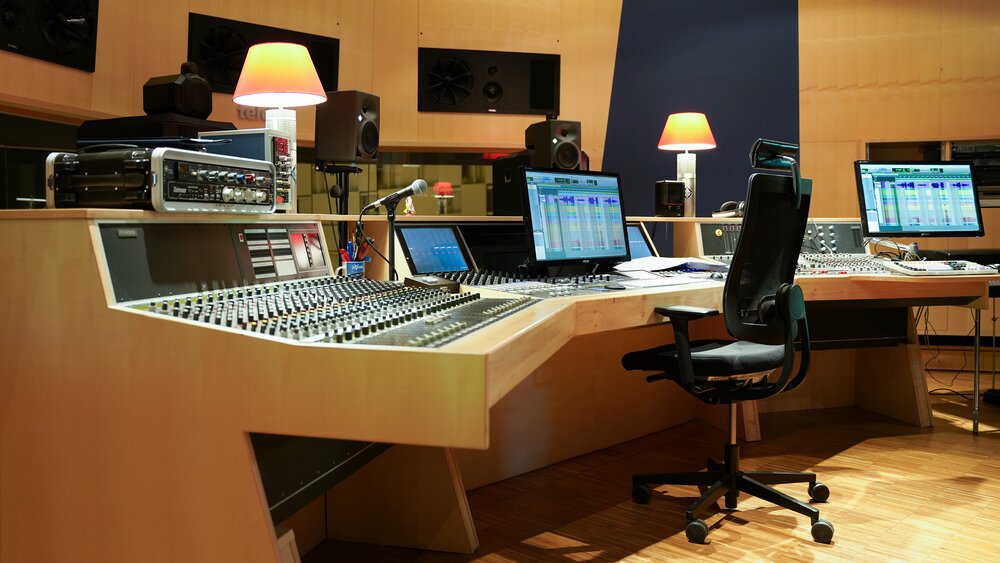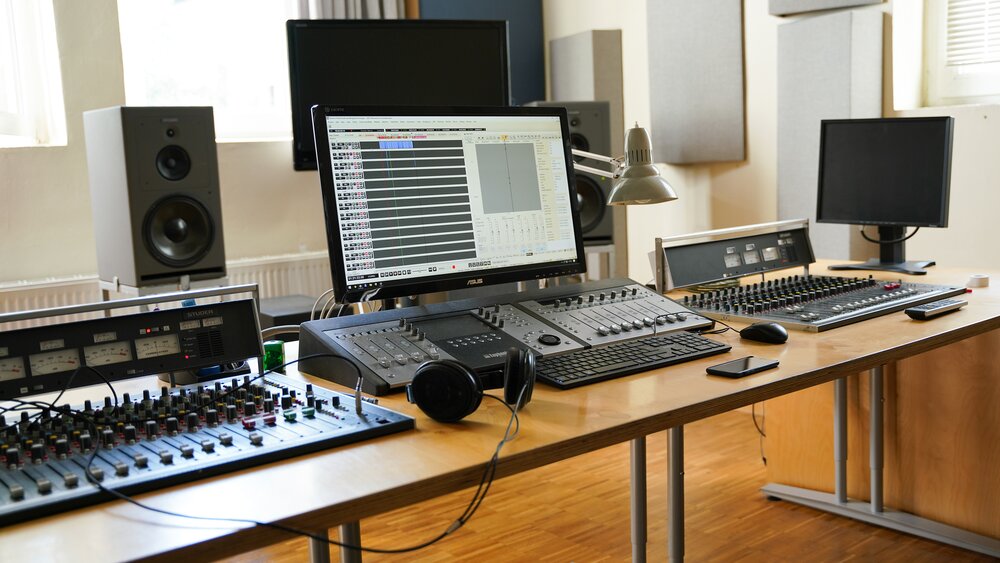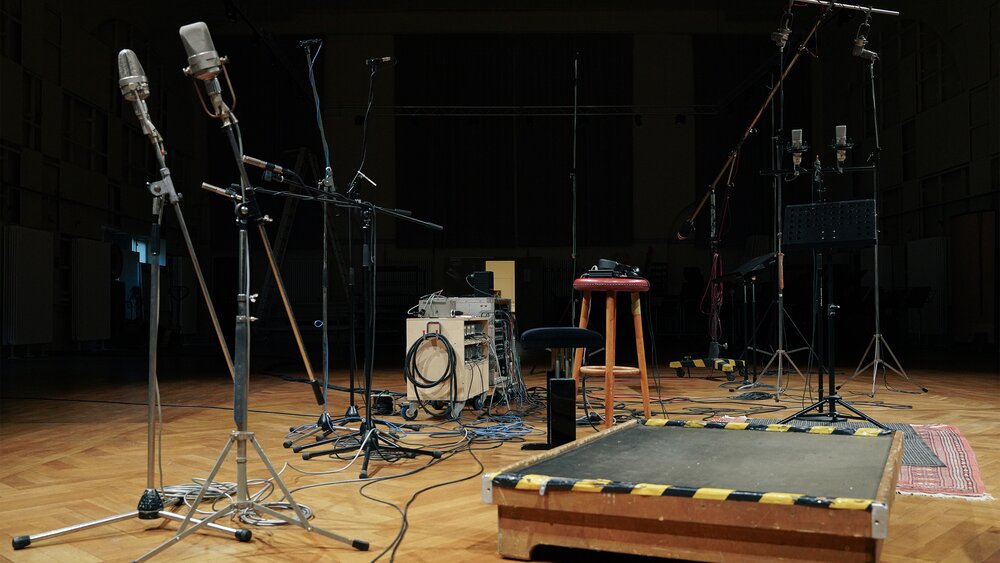by Peter Kirn

A small handful of studios can claim a combination of world-beating studio history and modern technique. Teldex has a combination all its own—a legacy of microphones and recording equipment; a history as one of Europe’s great large-scale studios; a leading mobile studio; and now a modern facility for classical, film, and immersive sound.
But forget all of that for a moment, because the first impression of Teldex Studios is just how nice the environment is. On the bright September day we visited, light streamed in through generous windows in the smaller project studios and workspaces. Leafy-green boughs hang outside the windows. Summer days support BBQ and beers outside. The studio doesn’t exclusively host classical music projects, but its calendar is full of them because it’s so uniquely well equipped for the task—and it’s a perfectly idyllic setting for hunkering down on the fine points of editing as well as recording. Think pastoral German environment for recording a Pastoral Symphony—all without ever leaving Berlin.

The died-and-gone-to-heaven feeling is of course completed by one of Europe’s deepest mic cabinets and biggest stages. The main studio’s floor has roughly the same size and dimensions of the largest uninterrupted area of Abbey Road’s Studio One. 80 or 100 musicians can fit in this space at a time. The 21st century reboot of the studio left the room largely as it was—home to over half a century of many of Germany’s best-known recordings and top orchestral sessions. There’s a partnership with Steinway Haus Berlin, which now has provided an older Steinway B and two younger Steinway Ds.
The updated Teldex approach is found in the control room, centered on a hybrid setup of both a generous Studer 980 analog mixer and an Avid (Euphonix) 5-MC controller. A smaller recording room also doubles Avid digital and a more compact Studer analog console. The desk itself says a lot about current Teldex culture—everything is hands-on, while still catering to the needs of today’s projects. The Studer, which replaced an earlier SSL console in the same space, represents the choice of a straightforward desk that allows easier DIY repairs. (Teldex does a lot of repair and maintenance on-site.) The 980’s surround channel configurations mostly get ignored, but it does see plenty of action for its superb mic pres and sound circuitry, making this convenient for the kind of big sessions Teldex naturally attracts. Teldex says they tend to rely on the Studer for preamps, but then a lot of projects will use EuControl for mixing in the box in Pro Tools.

That same philosophy carries into every other detail. “It has the tradition of Telefunken and Decca, but also has transformed into a modern business and a modern recording studio that works,” says Teldex producer and engineer Cornelius Dürst. “It continues the heritage we have from Teldec and Decca but tries to make something new out of it as well—while knowing where our roots are. I think it’s the same with the technical side—old-school analog gear but also some digital tools that just make life easier.”
To support this balance, Teldex has a variety of facilities ready for classical, scoring, video and livestreaming, and immersive work, plus mobile and remote production—the last of these having been busy during the pandemic. The Recording Hall dwarfs the rest of the complex, overlooked by Control Room 1 and smaller Recording Rooms 2 and 4 plus Control Room 2. True to its suburban surroundings, there are also ample lounge spaces. Additional production rooms support various phases of mixing and editing. The facility is also full service across mixing, mastering, online mixing, and editing, with support staff, as well.

Pro Tools is available throughout; side project studios are equipped with Pyramix for classical recordings. Seeing Pyramix on a bunch of monitors is the first indication some serious concert music editing is taking place.
One of those smaller production rooms has a dedicated 7.1.4 configuration for Dolby Atmos in addition to 5.1 surround, both for directly mixing to Atmos and upmixing materials. Netflix and Disney+ Germany make use of the facility. High-end 800 Series Bowers & Wilkins monitors are seemingly as numerous through the facility as are light switches (and Teldex tells us they see use for re-amping, too).
Deep in the bowels of the facility, there’s even one of the original echo chambers, which is usable even if less popular these days. The unassuming tile room has a vintage Klein+Hummel OY speaker and two Neumann KM84s for use, as it would have been configured historically. (Hey, what’s another pair of Neumanns in this facility?)

Big and beautiful as the large stage is, Teldex Studios might really be best understood from its storage closets, where the mic collections are housed. They’re always nearby, too—the mic locker is directly adjacent to the hall. Telefunken would bring its legendary mics into Teldex Studios for testing over the decades—which in the 1950s also included the golden age of Neumann microphones, then distributed by Telefunken.
That collection is deep—starting with a veritable Neumann and Telefunken museum, as you’d expect. From Neumann, you get M49, M50, U47 (both with tubes and FET modifications), U48, U67, U87, U89, M149, TLM50 and 170, plus the full SM and KM range too. And there are some rarities, as well. From Schoeps, another long-standing German name (also associated with Studer and Telefunken), there’s a 1969 CMTS501 stereo mic plus CMC 5-series mic pres. There’s a Bruel & Kjaer B&K 4006 and 4011 (from the maker that was predecessor to DPA). There are classic AKG condensers (C414, C422, D202, D112). There’s an RCA Type-77 and a Coles 4038, for the distinctive 1950s vintage ribbon mic sound of US and British broadcasters, respectively. All the usual necessities from Sennheiser are available, too.

M50s are the ‘go-to’ room microphone, Dürst explains. They are part of Teldex’s special sauce—an omni with a small diaphragm hiding inside the shell. “It makes for a really special sound,” says Dürst. “For us it’s a perfect mic in between a room mic and a close mic—this nice near feeling but also this depth that you get from a room microphone.”
It wouldn’t be the Teldec studio without a Decca Tree as a nod to the Decca and Teldec history. In short, this landmark mic technique involves setting up three omni mics in a triangular pattern adjustable to adapt to imaging and positioning. That balance of space and depth has helped the Decca tree to become part of the history of how to record symphonies. The approach came from Decca engineers working in London, Paris, and other locations, not necessarily Berlin, but the mics of choice were still the German M50—so Berlin’s advantage then as now was having both the minds and the mics. Teldex are just as ready to reconfigure for other approaches to sound, though, including now immersive Atmos recording.
Teldex Studios is not just what happens in Lichterfelde, but also recordings in Germany in the field. Every opera and every concert house in Berlin relies at least some of the time on Teldex Studios for recording equipment – meaning even if you’ve never been to Teldex, Teldex has probably come to you.

That road-tested practicality is embedded deeply in the facility—even that control room Studer 980 began its life as part of a mobile recording rig. (That’s mobile as in ‘truck,’ not ‘backpack,’ obviously.) In that mic closet, you’ll find as many road cases as mic cases, plastered in stickers from around the world. “They’ve seen a lot of airports; a lot of cars,” says Dürst.
“It’s our philosophy that what comes in front of the microphone is also important,” Dürst says. And that means everything. It’s the room, with its unique combination of original mid-century wooden panels for baffling, and selections and constructions of wood atop concrete. It’s the mic collection. It’s the people. And there’s the historical thread binding them all together, inside the building or working on mobile jobs.

While anyone may have some historical U67s around, Teldex is the one place where the mic you hold in your hand was used by the original Telefunken and Teldec engineers. Many of them have had the tubes replaced with more reliable FETs, but those modifications, too, come direct from the source (and mean they’ve held up to intensive use while still preserving their sound).
Maybe the best way to understand Teldex is having a history that’s alive—a direct lineage from the original Teldec, Decca, and Telefunken engineers to today’s staff, directly received know-how alongside the full collection of equipment. That’s especially vital in classical music, which demands natural sound and transparency—“passed on from engineer to engineer,” Dürst says. “It’s this line of knowledge that’s been passed on—getting to know the room, and what microphones work best, and what position has been passed on from generation to generation,” he says. It’s “a sound way of thinking. This building houses some tradition.”